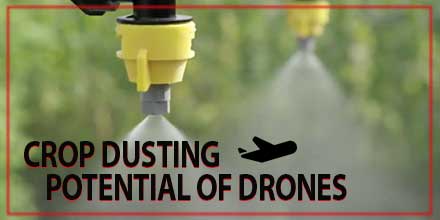
Drones, though more common today, have disrupted the way various industries choose to conduct business. From film-making to surveying and photogrammetry, drones help make processes easier, faster and more affordable.
Today, designers and manufacturers of unmanned aerial vehicles are turning their attention to the farm industry. One area of interest is the potential of crop dusting drones. And with drones featured heavily at agricultural shows, farmers are increasingly aware of their potential.
Industry takes notice
A number of UAV companies – manufacturers and businesses alike – have made inroads into the crop dusting industry. Drone manufacturer DJI recently released the DJI Agras MG-1. Designed specifically for agriculture, it features eight rotors powerful enough to lift over 22 pounds of spraying liquid.
Integrated Precision Agriculture, out of Galesburg, Illinois, is currently conducting spraying tests with local farmers. IPA hopes to begin commercial operations early next year once its license is approved. Currently IPA is using two drones – a DJI Inspire for land surveying and a larger vehicle for spraying crops. The company reports that enthusiasm for its surveying and spraying services from farmers is high.
The use of drones to spray crops on large farms is similar to the traditional methods widely used today. However, drone technology does offer many useful advantages in crop dusting.
To begin, drones can survey crops and gather data on large tracts of land affordably and relatively quickly. Furthermore, with the ability to map the drone's flight path, UAVs are actually a more efficient method of crop dusting.
Environmental factors
Another crucial benefit is the reduction of chemical drift.
Traditional crop dusting planes fly at higher altitudes. This greater height allows some of the pesticide to drift into neighboring fields and environments. Drones, in contrast, offer more targeted dusting. Drone can fly much closer to crops which, in turn, can reduce chemical drift. Plus, drones are battery powered which adds to its environmental credentials.
As advances continue, the full potential of crop dusting drones is just a matter of time. What farmer's choose to do with this emerging technology is still in question.
Early adopters may simply hire commercial companies such as IPA to replace traditional methods. Other farmers may choose to invest in the technology and conduct their own spraying flights - gaining full control over both projects and expenditures.
It is clear that drones have a lot of potential in the crop dusting industry. The many benefits they afford both farmers and the environment makes them an excellent fit for the task at hand.
 Drones, though more common today, have disrupted the way various industries choose to conduct business. From film-making to surveying and photogrammetry, drones help make processes easier, faster and more affordable.
Today, designers and manufacturers of unmanned aerial vehicles are turning their attention to the farm industry. One area of interest is the potential of crop dusting drones. And with drones featured heavily at agricultural shows, farmers are increasingly aware of their potential.
Drones, though more common today, have disrupted the way various industries choose to conduct business. From film-making to surveying and photogrammetry, drones help make processes easier, faster and more affordable.
Today, designers and manufacturers of unmanned aerial vehicles are turning their attention to the farm industry. One area of interest is the potential of crop dusting drones. And with drones featured heavily at agricultural shows, farmers are increasingly aware of their potential.

